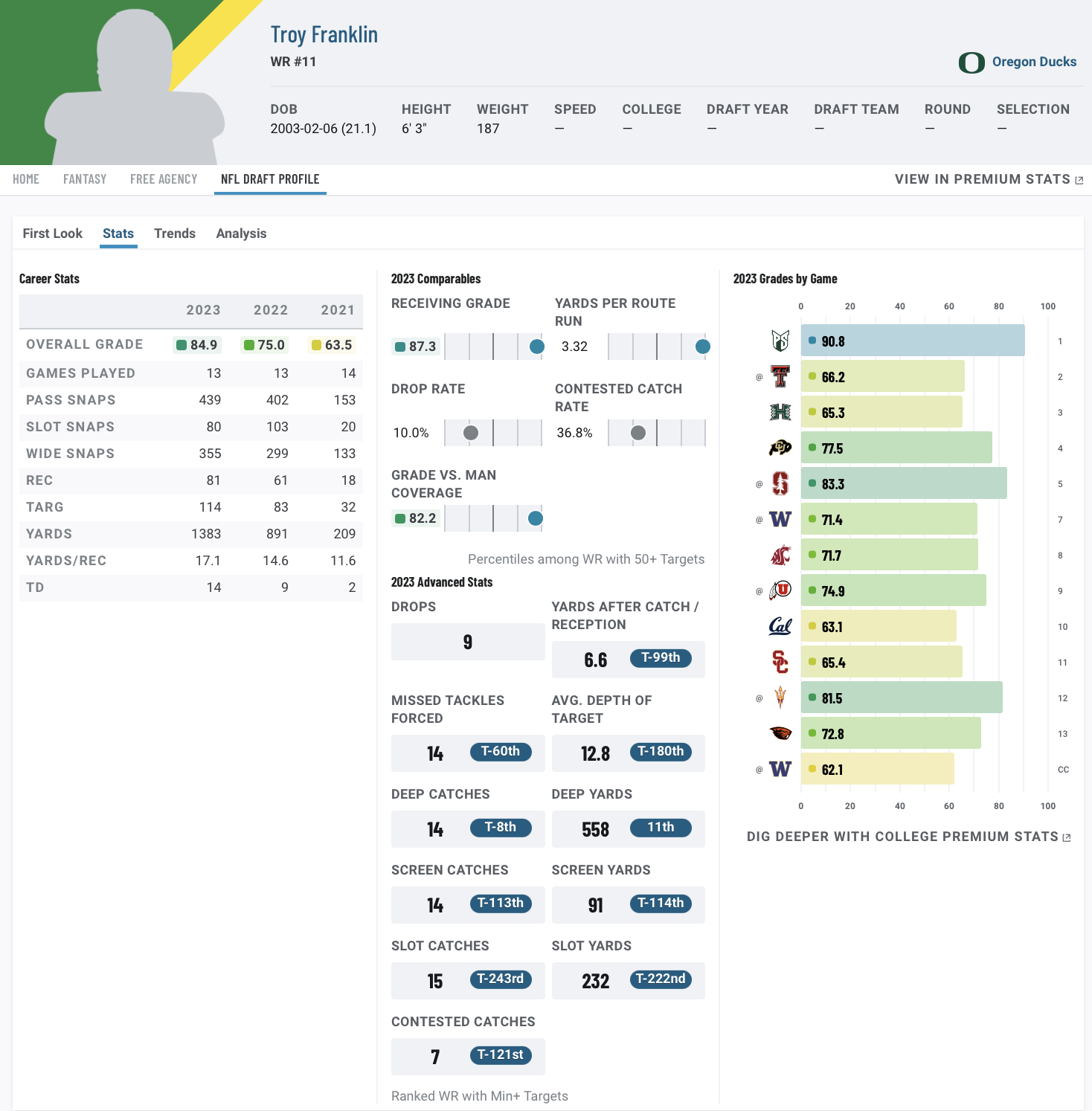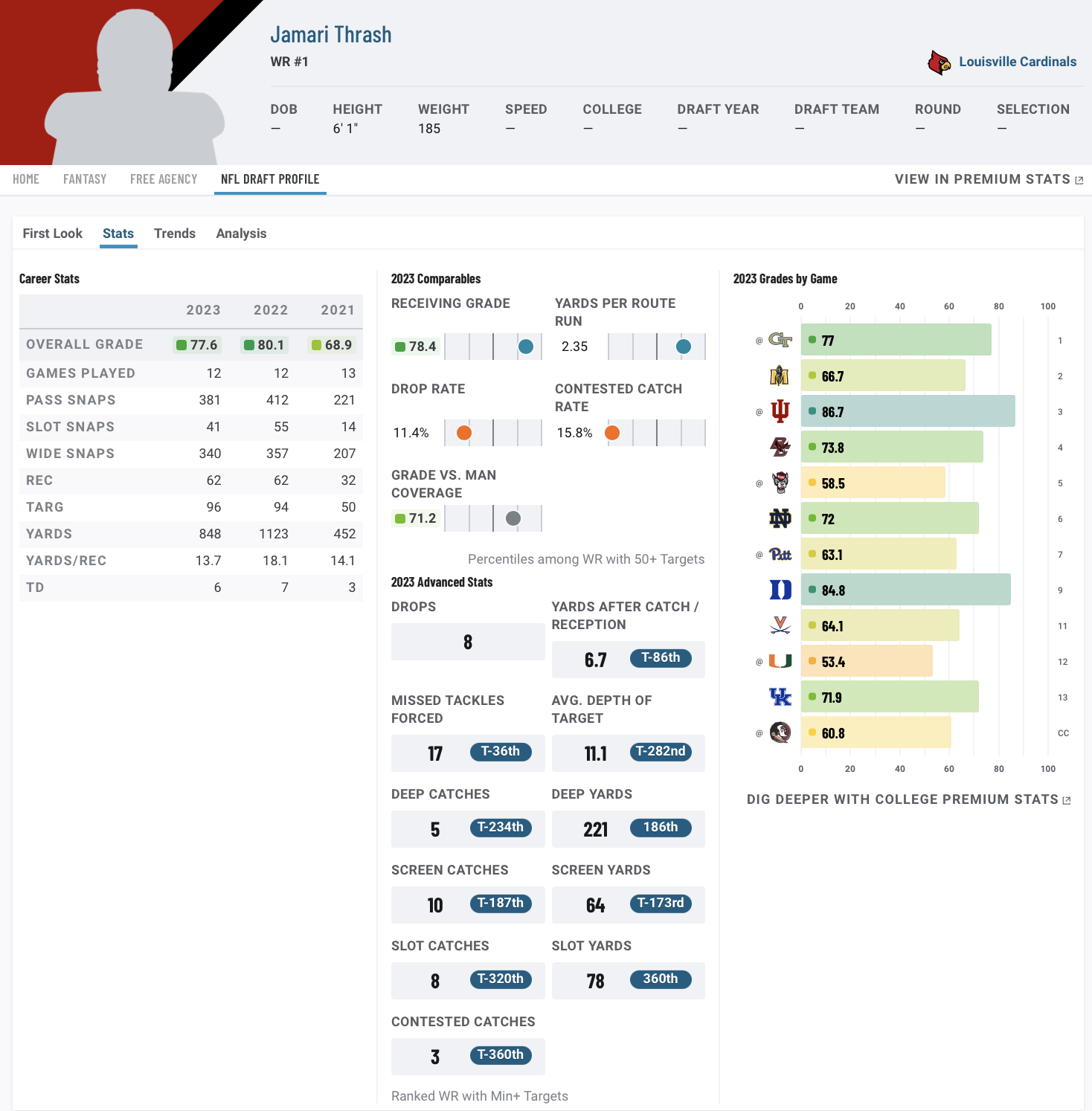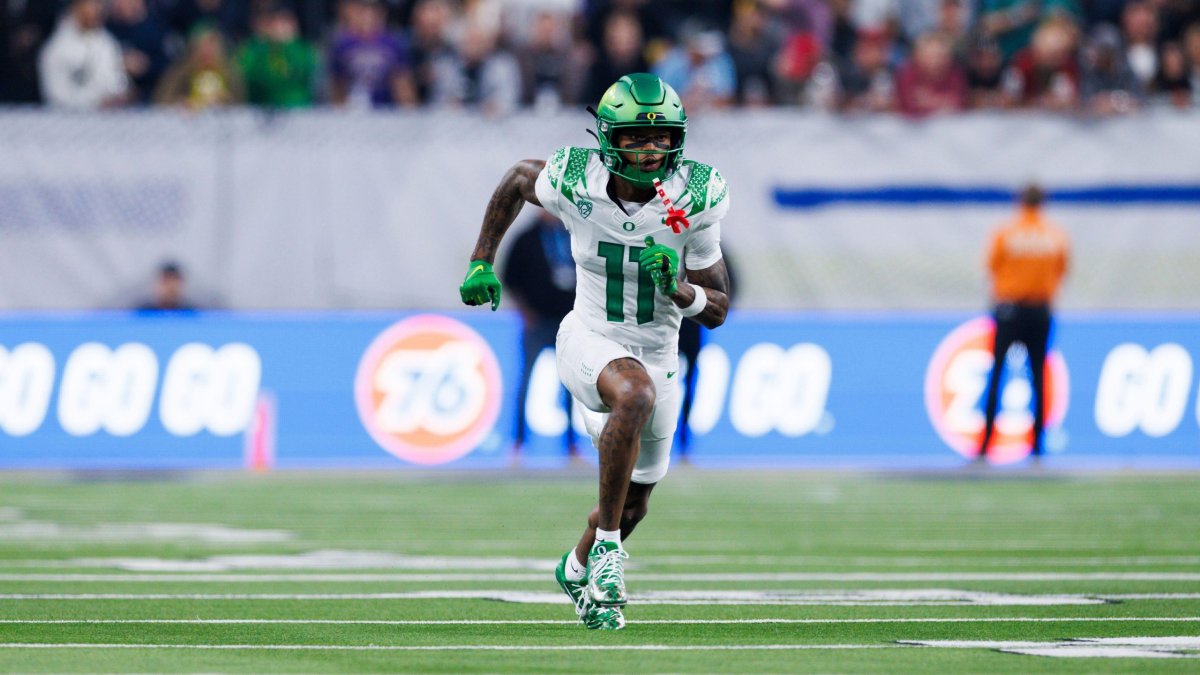• Troy Franklin boasts the most promising profile outside the top three: After the clear top three wide receivers in this year’s class, Oregon’s Franklin comes in not too far behind with some very encouraging metrics.
• Florida State’s Johnny Wilson intrigues: Between his incredible size and athleticism, Wilson brings some interesting production numbers despite not truly breaking out during his college career.
• Try PFF's mock draft simulator: You can trade picks and players and draft up to five rounds for your favorite NFL team.
Estimated Reading Time: 10 minutes
After going over some of the standout analytical data from the top-five wide receivers in this year’s class, we'll now shift our focus to potential sleepers who rank outside of the top five on the PFF big board and could be deserving of more love heading into the draft.
A few notes before diving into these receivers:
- These “sleepers” will be players who rank in the 75th percentile in the college production model and rank outside the top five players at their position coming into the 2024 NFL Draft.
- Overall percentile rank is based on a model that includes a player’s yards per route run for their career, from specific alignments and against single coverage, as well as their best single-season marks. Also included are other stable metric categories, such as yards after catch per reception and separation rate, the latter of which has been adjusted to focus on targets deeper downfield.
- This model includes all wide receiver prospects over the past five years (since 2019).
- Strengths are considered production data points where a particular wide receiver scored the highest in comparison to the prospect pool dating back to 2019.
- Weaknesses are the areas where a particular wide receiver scored below the 50th percentile in that particular production category compared to the prospect pool since 2019.
- While this is far from a perfect method, players that this model has identified in the past that fit the above criteria include Puka Nacua (93rd percentile), Christian Watson (86th percentile), Diontae Johnson (86th percentile), Tank Dell (76th percentile) and Brandon Aiyuk (76th percentile).
Troy Franklin, Oregon
- No. 7-ranked wide receiver on the PFF big board
- 89th percentile production profile among college wide receiver prospects since 2019
- PFF Mock Draft Simulator ADP: 36.5
Franklin’s sleeper status is borderline in that he is trending toward being a late first-round pick/early second-round pick. However, he is also ranked outside the top five at his position on the PFF big board. Based on his production profile, he could be deserving of a top-five ranking.
Franklin posted some of the most encouraging numbers against single coverage, not just compared to this year’s class, but among all prospects since 2019. His 5.10 yards per route run in that regard ranks in the 94th percentile, and when looking at receivers with at least 90 targets against single coverage, Franklin ranks fourth — behind only DeVonta Smith (5.95), Tee Higgins (5.32) and Ja’Marr Chase (5.25).
Franklin’s Career College Analytical Strengths
| Metric | Value | Rank Among WR Prospects Since 2019 |
| Yards per route run versus single coverage | 5.10 | 94th percentile |
| Adjusted separation rate (10-plus yards ADoT) | 45% | 92nd percentile |
| Yards per route run | 2.63 | 80th percentile |
| Explosive play rate | 40.6% | 75th percentile |
| First down/touchdowns per route run | 0.14 | 80th percentile |
Franklin ends up so high on the college production model — and fourth in this year’s class — largely because there weren’t many areas where he showed true weaknesses. There was just one category collected where he ranked below the 50th percentile in production since 2019, and that was his yards after catch per reception (5.5).
Franklin did have a couple of other categories that were low compared to the rest of his profile — but not so much that they are major concerns. His missed tackles forced per reception (0.18) ranked in the 59th percentile of prospects since 2019, as did his targets per route run (0.24). Again, these aren’t terrible numbers, especially when looking at his profile as a whole, as he pushes for a case to be a top-five wide receiver in this class.
Franklin’s College Analytical Weaknesses
| Metric | Value | Rank Among WR Prospects Since 2019 |
| YAC/reception | 5.5 | 44th percentile |

Javon Baker, UCF
- No. 17-ranked wide receiver on the PFF big board
- 78th percentile production profile among college wide receiver prospects since 2019
- PFF Mock Draft Simulator ADP: 98.5
Baker is trending toward being a Day 3 pick, making him a true sleeper in this year’s class, as the success rate for such prospects begins to get much lower outside of the first two rounds. That being said, Baker has an encouraging production profile that puts him among players who, on average, were drafted within the first 84 picks in their respective draft class — up from Baker’s current trend of being the 99th player drafted, according to the PFF Mock Draft Simulator.
Baker, much like Troy Franklin, thrived against single coverage during his college career, posting an elite 93.6 receiving grade (96th percentile) and 5.07 yards per route run (94th percentile). Baker rounds out the top five wide receivers in yards per route run versus single coverage who faced at least 90 targets in that regard since 2019, just behind Franklin.
Baker’s Career College Analytical Strengths
| Metric | Value | Rank Among WR Prospects Since 2019 |
| Yards per route run versus single coverage | 5.07 | 94th percentile |
| Receiving grade versus single coverage | 93.6 | 96th percentile |
| Best single-season yards per route run | 3.21 | 77th percentile |
| Explosive play rate | 44.4% | 90th percentile |
While Baker has some encouraging numbers that suggest he’s worthy of a higher spot in the draft, there are also numbers on the lower end. Among them are missed tackles forced per reception (53rd percentile) and targets per route run (59th percentile), but there were only two areas where he fell below the 50th percentile threshold.
Baker’s adjusted separation rate (25%) is a concern for a player with a higher average depth of target (15.1) for the past two years as a starter, but he did well to bring in contested catches (54.0%) — though that isn’t typically a stable metric. Baker should still be considered a longshot to succeed in the NFL, with optimistic outcomes being similar fantasy success to Gabe Davis or Romeo Doubs, though more likely outcomes closer to David Bell or Dyami Brown.
Baker’s College Analytical Weaknesses
| Metric | Value | Rank Among WR Prospects Since 2019 |
| YAC/reception | 5.6 | 47th percentile |
| Adjusted separation rate (10-plus yards ADoT) | 25% | 44th percentile |
Jamari Thrash, Louisville
- No. 19-ranked wide receiver on the PFF big board
- 77th percentile production profile among college wide receiver prospects since 2019
- PFF Mock Draft Simulator ADP: 81.7
Thrash is another likely Round 3 pick, at best, currently going in that range in PFF'sMock Draft Simulator. Thrash’s strong production profile includes a positive showing against single coverage, much like Troy Franklin and Javon Baker before him. Thrash also shares the exact same receiving grade against single coverage as the No. 3-ranked wide receiver on the PFF big board, Rome Odunze, with a slightly better yards per route run.
Thrash spent the majority of his college career lined up out wide, and he provided strong production out of that alignment, including a 78th percentile receiving grade (82.9) and a 71st percentile yards per route run figure (2.52).
Thrash’s Career College Analytical Strengths
| Metric | Value | Rank Among WR Prospects Since 2019 |
| Yards per route run versus single coverage | 4.47 | 87th percentile |
| Receiving grade versus single coverage | 92.1 | 89th percentile |
| Yards per route run | 2.52 | 72nd percentile |
| Receiving grade when lined up wide | 82.9 | 78th percentile |
Thrash’s good analytical profile comes from not having too many significant weaknesses, much like the others on this list. There are still some red flags to be aware of, however. His best single-season receiving grade — which came in 2022 — failed to crack the 50th percentile of prospects since 2019. After transferring from Georgia State in the Group of Five to Louisville in the Power Five, he was unable to build on his strong production and even saw a slight decline in his overall production against tougher competition.
This makes Thrash a tougher sell, especially considering that four years' worth of his production came against Group of Five competition. But even with that accounted for, he still ranked highly enough to be included in this list.
Thrash’s College Analytical Weaknesses
| Metric | Value | Rank Among WR Prospects Since 2019 |
| Best single-season receiving grade | 81.5 | 49th percentile |
| Explosive play rate | 34.1% | 42nd percentile |

Johnny Wilson, Florida State
- No. 18-ranked wide receiver on the PFF big board
- 75th percentile production profile among college wide receiver prospects since 2019
- PFF Mock Draft Simulator ADP: 76.8
Wilson is one of the bigger wide receivers in this year’s class, with an impressive wingspan and excellent athletic profile, and he earned high marks in this college production model. Wilson wasn’t quite as productive from a volume perspective in 2023 as teammate Keon Coleman, but his career as a whole — which these numbers are mostly based on — is much stronger. Wilson even owns the top explosive play rate among wide receivers in this year’s class (48.0%), which places in the 98th percentile of prospects since 2019, just ahead of Ja’Marr Chase.
Helping Wilson’s production profile is his 2022 season with 3.36 yards per route run, which lands him in the 72nd percentile of prospects in career yards per route run since 2019. After that strong season, and even while missing time with injury in 2023, Wilson still produced some positive outcomes for his college career and stands out as a big-play threat who has commanded targets at a strong rate.
Wilson’s Career College Analytical Strengths
| Metric | Value | Rank Among WR Prospects Since 2019 |
| Explosive play rate | 48.0% | 98th percentile |
| Best single-season yards per route run | 3.36 | 84th percentile |
| Yards per route run when lined up wide | 2.57 | 76th percentile |
| Missed tackles forced per reception | 0.21 | 75th percentile |
| Yards per route run versus single coverage | 4.09 | 77th percentile |
| Targets per route run | 0.26 | 77th percentile |
Wilson could be viewed as a player who didn’t truly break out during his college career, having never exceeded 900 receiving yards or five touchdowns in a season. His career receiving grade reflects that, as well, ranking just below the 50th percentile.
Wilson also had a lower adjusted separation rate (39%), which isn’t a significant concern, nor is it necessarily out of the ordinary for a receiver of his size. He lands in a bucket with Tee Higgins, A.J. Brown, Michael Pittman and Puka Nacua — all of whom posted similar or slightly worse in this category and were drafted outside of the first round.
Wilson’s College Analytical Weaknesses
| Metric | Value | Rank Among WR Prospects Since 2019 |
| Receiving grade | 79.4 | 49th percentile |
| Adjusted separation rate (10-plus yards ADoT) | 39% | 24th percentile |
| YAC/reception | 5.3 | 38th percentile |
Jacob Cowing, Arizona
- No. 22-ranked wide receiver on the PFF big board
- 75th percentile production profile among college wide receiver prospects since 2019
- PFF Mock Draft Simulator ADP: 107.8
Cowing is the lone player on this list currently going outside of the top 100 picks in PFF's Mock Draft Simulator, making him the deepest sleeper of the group. He has also been one of the most productive wide receivers in this year’s class, with more than 4,500 receiving yards and 33 touchdowns over five seasons. Cowing did spend the first three years of his college career in the Group of Five with UTEP, so it isn’t too surprising that his production declined a bit after transferring to Arizona in the Power Five.
The positives for Cowing in the Power Five are that he saw at least 120 targets and had 85 receptions in both seasons while combining for 20 touchdowns — a career-high 13 of which came in 2023. Cowing’s career 90.7 receiving grade should not be overlooked, as his worst season-long mark was 71.2 as a freshman in 2019.
Cowing’s Career College Analytical Strengths
| Metric | Value | Rank Among WR Prospects Since 2019 |
| Best single-season yards per route run | 3.82 | 94th percentile |
| Receiving grade | 90.7 | 90th percentile |
| Receiving grade when lined up in the slot | 87.9 | 85th percentile |
| Targets per route run | 0.28 | 85th percentile |
Cowing’s average depth of target dropped off significantly after he transferred from UTEP (15.7) to Arizona (7.6), also cutting down his explosive play rate. Not helping matters for him was that in 2023, when he had his lowest average depth of target (6.7), he posted just eight total forced missed tackles as a receiver, which led to a career-low 1.92 yards per route run and just 5.8 yards after the catch per reception.
Cowing has performed well, however, in different offenses across multiple conferences, which does make him intriguing when looking at the rest of his production profile. He compares more as a late Day 2 pick than the Day 3 prospect that he currently is.
Cowing’s College Analytical Weaknesses
| Metric | Value | Rank Among WR Prospects Since 2019 |
| Explosive play rate | 33.3% | 39th percentile |
| Missed tackles forced per reception | 0.13 | 35th percentile |
| Yards per route run versus single coverage | 3.09 | 48th percentile |




 © 2024 PFF - all rights reserved.
© 2024 PFF - all rights reserved.